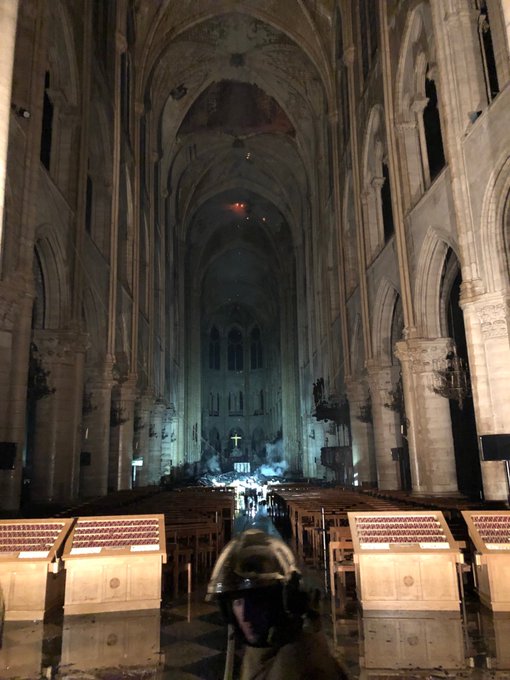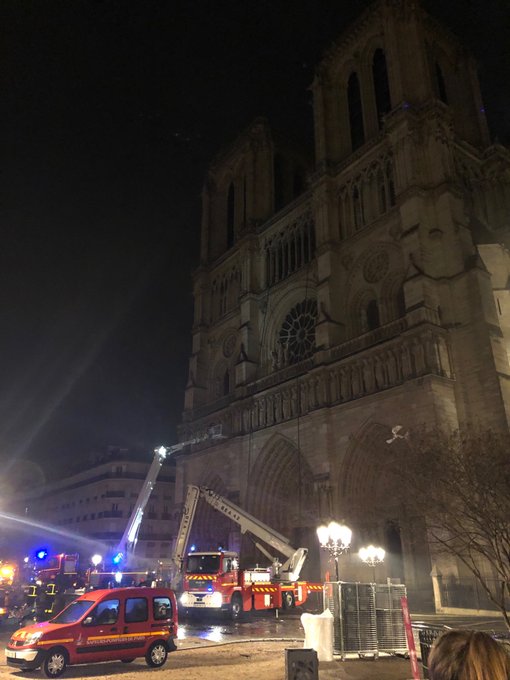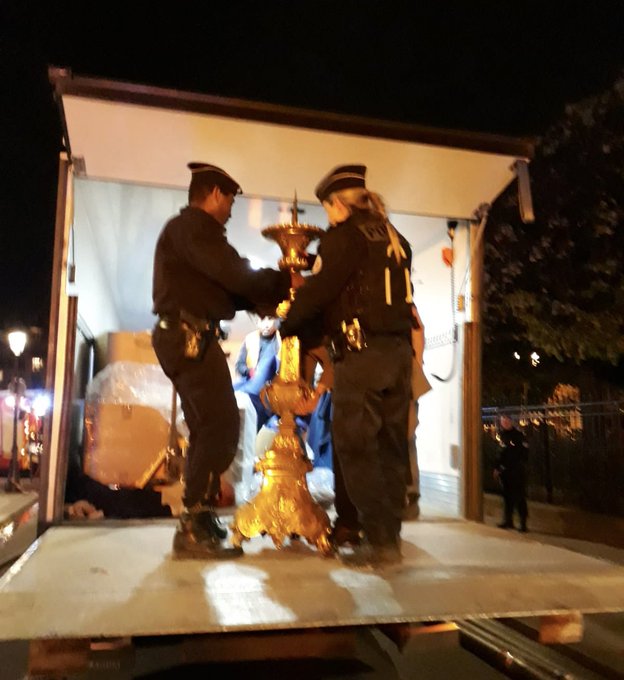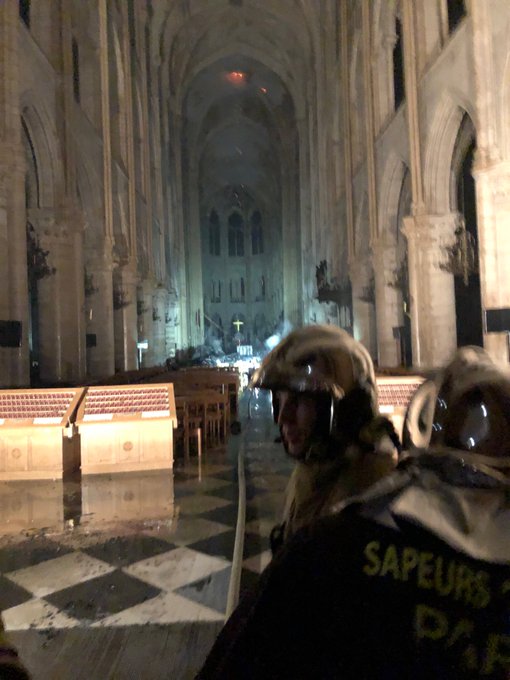
Getty The Notre Dame rose windows were imperiled by the blaze.
The three large stained-glass rose windows at Notre Dame Cathedral are among the landmark’s most famous elements. However, did they survive the blaze that ravaged the building?
There were some ominous signs early on that the rose windows were damaged. However, great news emerged with the morning’s light: The three rose windows were saved.
The Archbishop of Paris “said all three have been saved,” CNN reported.
“From what I could see, the stained glass had not been touched, the three beautiful roses that date back to the 12th and 13th century were still there,” André Finot, spokesman of the cathedral, told BFM Paris.
“The stained glass windows of the 12th and 13th centuries of the rosettes of Notre-Dame were spared by the flames,” the French news site concluded. Photos emerged from inside the cathedral on the day after the fire, showing a rose window gleaming in the daylight.
The French language BFM Paris also wrote: “Crown of thorns, tunic of St. Louis, rosettes… The treasures of our Lady saved from the flames.” (Couronne d’épines, tunique de Saint-Louis, rosaces… Les trésors de Notre-Dame sauvés des flammes.)
There may be some damage to the windows, but they are intact. According to The New York Times, Benoist de Sinety, a bishop of the Archdiocese of Paris, said “high heat had damaged the windows, melting the lead that held their panes in place.”
That account was the most specific revelation about the fate of the rose windows in the hours after the fire struck on April 15, 2019. French Journalist Laurent Valdiguie reported from the scene earlier that there was hope but still danger for the north window, La Rosace Nord: “North face the rosettes seem to have held. On the street, on the ground, no debris of stained glass. Just old broken stones… ‘we stay worried’ slips a fireman.” Amazingly, the windows survived.
Here’s what you need to know:
Reports on Social Media That the Rose Windows Had ‘Exploded’ Were Not True, Thankfully
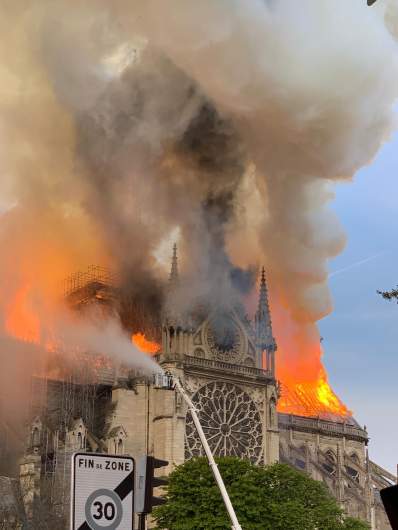
Flames and smoke are seen billowing from the roof at Notre-Dame Cathedral in Paris on April 15, 2019.
After the blaze first erupted, the fate of the rose windows was not certain. The massive inferno threatened them, and there were even reports on social media that they had “exploded.”
“The survival of Notre-Dame’s three great stained-glass Rose windows, each of which tells a Bible story, is still uncertain,” wrote AFP. “At least one appeared still intact after firefighters spent hours battling the blaze that engulfed the UNESCO-Listed cathedral.”
However, the fact that some smaller stained-glass windows might not have survived the fire could have created confusion.
Some stained-glass windows were damaged in the cathedral, but not the famous large rosettes. “These are stained glass windows of the 19th century, much less important that may have been touched, but not the jewels of the 13th century… is a bit of a miracle, we are very relieved,” the spokesman of the cathedral said to the French news channel, BFM Paris.
French journalist Nicolas Delesalle eloquently wrote of the battles to save the structure and its treasures: “Firefighters circulate on the balconies above the rosette, we see their torches illuminate the stone of the façade intact. Behind, the fire continues to ravage. But the glow in the left Tower is gone.”
Photos showed the outside of a rose window:
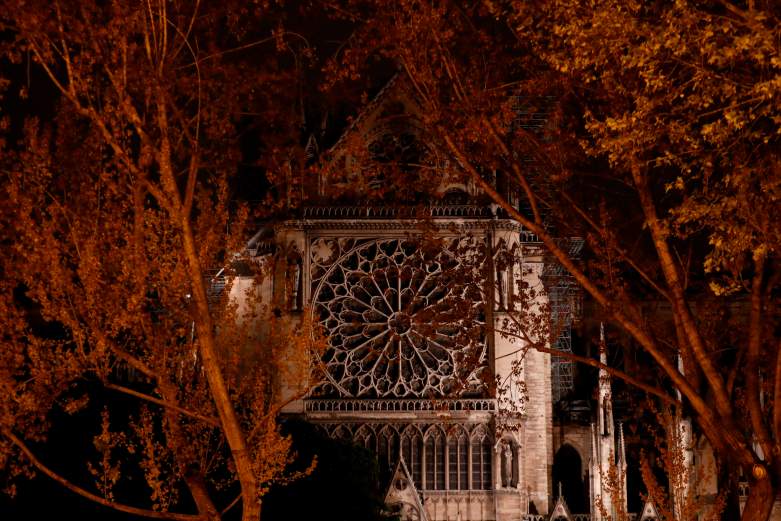
Firefighters (L) work to contain a fire near the north rose window at Notre-Dame Cathedral in Paris early on April 16, 2019.
Here’s another view:
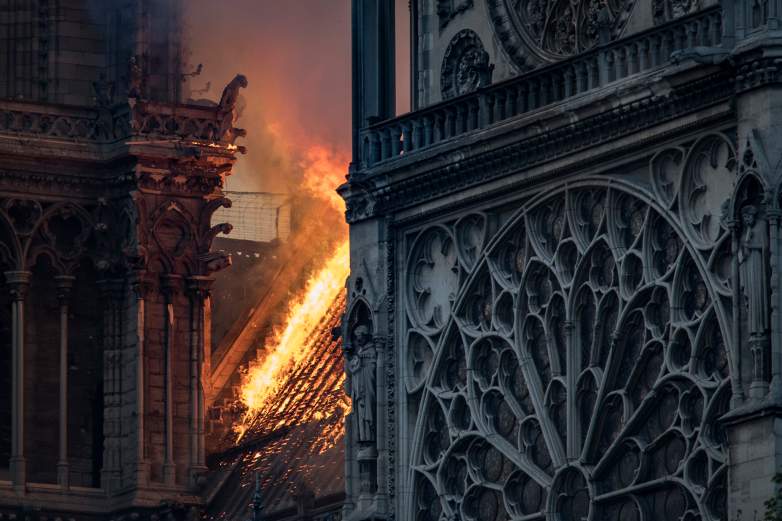
GettyFlames and smoke are seen billowing from the roof at Notre-Dame Cathedral in Paris on April 15, 2019.
Notre Dame is embedded in the psyche of Paris, and the sight of it on fire devastated the French, and people all over the globe.
“Notre Dame is our history, our literature, part of our psyche, the place of all our great events, our epidemics, our wars, our liberations, the epicentre of our lives … So I solemnly say tonight: we will rebuild it together,” declared French President Emmanuel Macron.
Journalist Agnes Poirer wrote on Twitter, “Firemen say #NotreDame’s structure is now considered safe, the North tower has been saved. One fireman severely injured. Roof almost entirely destroyed. Upper rose windows melted. The fate of the lower big rose windows dating back to 1260 is yet unknown.” Such reports set up a flurry of consternation that the great windows might be lost.
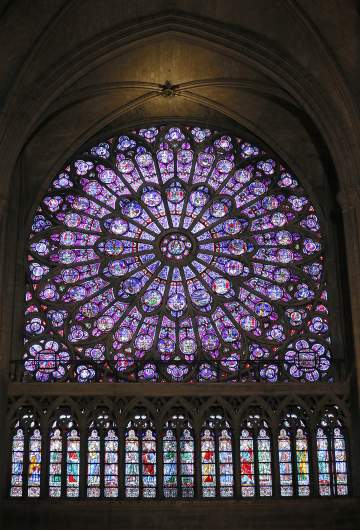
A view of the middle-age stained glass rosace on the northern side of the Notre-Dame de Paris cathedral, on November 29, 2012.
Thankfully, some of the cathedral’s most sacred religious relics also survived the inferno, which authorities preliminarily believe may have accidentally ignited due to renovations. The Crown of Thorns, which is believed to contain fragments of the braided circle worn by Jesus Christ during the Crucifixion, was saved, according to the mayor of Paris. The famous bell towers were saved, The Guardian reported.
A picture emerged showing works of art being carted out of the cathedral. It was posted by France’s culture minister, Franck Riester, who wrote, “@MinistereCC agents, supported by the archbishop’s teams, the @PompiersParis and the security forces, evacuate the works inside the cathedral. They are gradually made safe. #Our Lady.”
Paris fire commander Jean-Claude Gallet explained to reporters. “We can consider that the main structure of Notre-Dame has been saved and preserved.” The fire did not spread to the northern belfry, according to Gallet. He also said: “We consider the two towers of Notre Dame to have been saved.”
The Iconic Rose Windows Are Considered One of the ‘Greatest Masterpieces of Christianity’
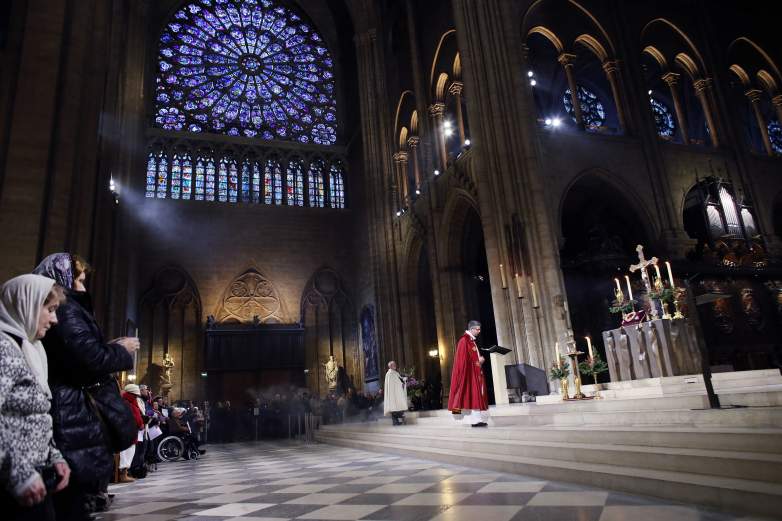
GettyBelievers attend a mass during the presentation to believers of the crown of thorns, one of the instruments of Jesus’ Passion at Notre-Dame de Paris cathedral, on December 7, 2012 in Paris. The Notre-Dame de Paris cathedral.
The three rose windows were built in the 13th century, BBC reports. CNN describes them as “immense round stained-glass windows over the cathedral’s three main portals.”
According to Agence France Presse, the three rose windows “represent the flowers of paradise, were built in the 13th century, then renovated several times. The north and south rosettes, the two largest, are 13 meters in diameter.”
In the rose windows, one can see images of “prophets, saints, angels, kings, scenes of the life of saints, etc. The three rosettes present respectively in their center the Virgin, the Child Jesus and the Christ in majesty,” AFP reports.
The cathedral’s website says that the three rose windows of the Notre-Dame Cathedral in Paris “constitute one of the greatest masterpieces of Christianity.”
One of the most famous is the South Rose window.
“The South Rose or Rose du Midi was offered by King Saint Louis. The masters who designed it are Jean de Chelles and Pierre de Montreuil. The first architect of the Cathedral, Jean de Chelles, had the first stone of the south transept walled in 1258,” the website explains.
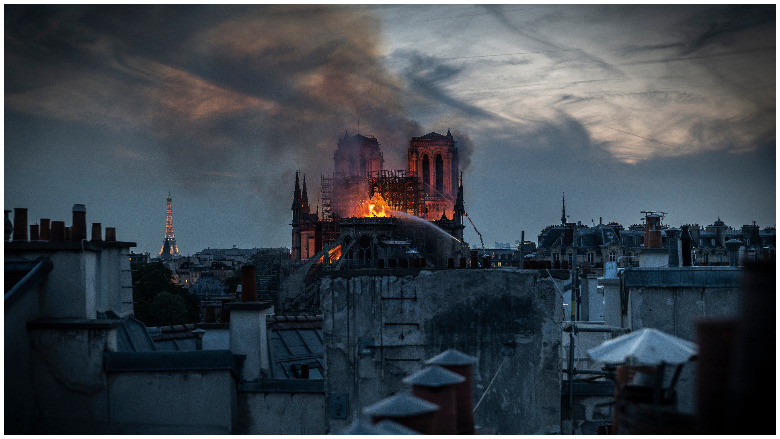
GettyAuthorities don’t suspect terrorism in the Notre Dame fire.
“The Rose of the South symbolizes therefore the triumphant Christ sitting in Heaven, surrounded by all those who have been his witnesses on earth….The South Rose, veritable central piece enthroned on the facade of the transept, was built in 1260 in echo with the rose of the northern cross, built, meanwhile, around 1250. As its northern pendant, the South Rose, sees its diameter to reach 12.90 meters, and, if we add the skylight on which it rests, the Total height of glazing is almost 19 meters.”
This rosette is dedicated to the New Testament, according to the Notre-Dame website.
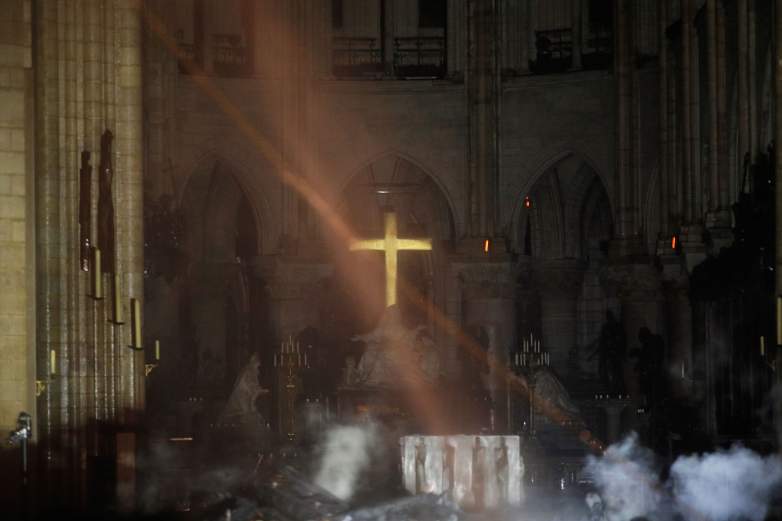
GettySmoke rises around the altar inside Notre Dame.
“It has eighty-four panels spread over four circles. The first has twelve medallions, the second twenty-four. A third circle consists of twelve quadrilobes, while the fourth circle is punctuated by twenty-four trilobed medallions. We thus find the symbolic number four, as well as its multiples, twelve and twenty-four.”
The South Rose window has survived destruction before.
“This rose has suffered a lot of damage over the centuries,” the Notre-Dame website says. “Supported since 1543 as a result of settlements in the masonry, it was restored between 1725 and 1727 by Guillaume Brice under the direction of Boffrand. However, poorly executed works, as well as the fire of the archbishop during the revolution of 1830 which severely altered the rose window, resulted in the need for a new reconstruction. It was then undertaken in 1861 by Viollet-le-Duc.”
Changes were made. “In the face of the pronounced slump of the masonry, he completely resumed the facade of the southern cross and rotated the rosette by 15 ° to give it a vertical axis and a horizontal axis, consolidating the stone lace,” the website says. “The master glassmaker Alfred Gérente restored the stained glass windows of the 13th century and reconstructed the medallions missing in the spirit of authenticity of the whole.”

